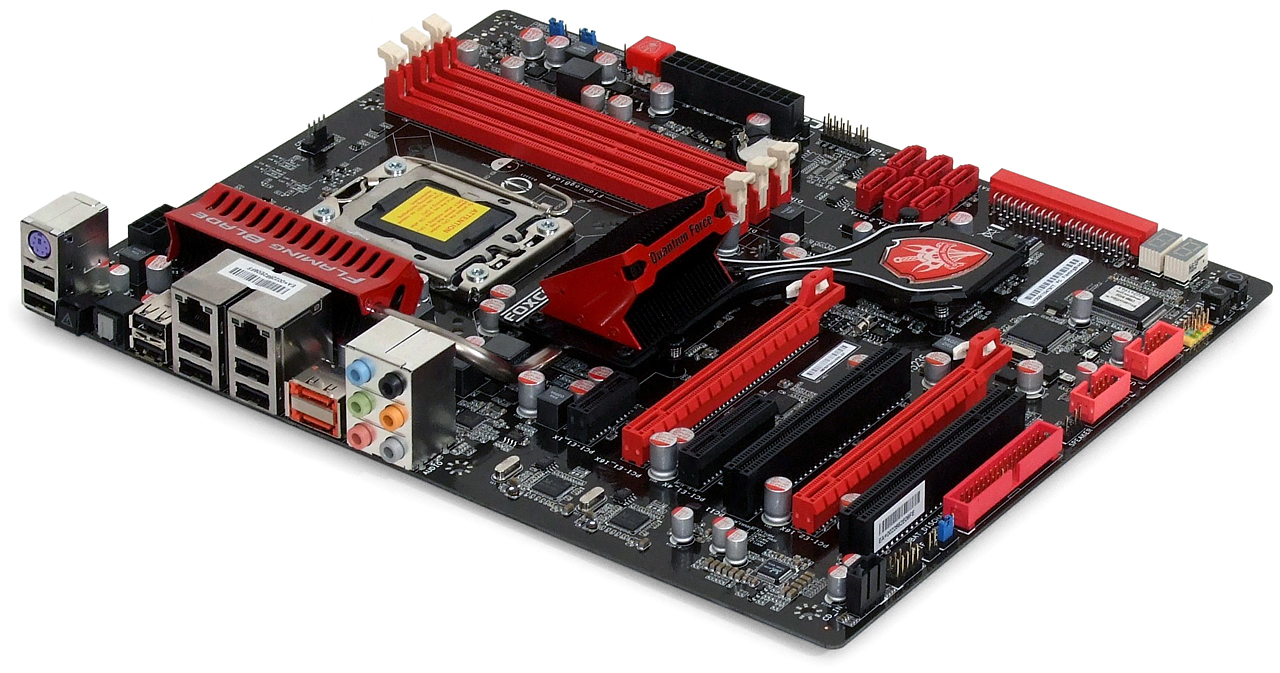DDR3 On A Budget: Six 6 GB Memory Kits
Test System Configuration
| Test System Configuration | |
|---|---|
| CPU | Intel Core i7-920 (2.66 GHz, 8.0 MB Cache) |
| CPU Cooler | Swiftech Apogee GTZ Liquid Cooling |
| Motherboard | Foxconn Flaming Blade, BIOS P05 (04/13/2009) Intel X58/ICH10R Chipset, LGA-1366 |
| Graphics | Zotac GeForce GTX260² 896MB 576/999MHz GPU/Shader, GDDR3-2484 |
| Hard Drive | WD VelociRaptor WD30000HLFS 300 GB, 10,000 RPM, 16 MB Cache |
| Sound | Integrated HD Audio |
| Network | Integrated Gigabit Networking |
| Power | Cooler Master RS850-EMBA 850W, ATX12V v2.2, EPS12V |
| Optical | Lite-On LH-20A1L, 20X DVD±R |
| Software | |
| OS | Microsoft Windows Vista Ultimate x64 SP1 |
| Graphics | NVidia Forceware 182.08 |
| Chipset | Intel INF 9.1.0.1007 |
Foxconn’s FlamingBlade
has the highest stable memory speed of any motherboard we’ve tested, and that makes it a great choice for overclocking today’s test modules. We set its BIOS to 1.65 V DIMM and +0.36V CPU VTT (Uncore) for today’s test.
Unfortunately, we found out after testing began that this particular motherboard and BIOS has a bad habit of resetting tRAS values at reboot. Timings of 17, 18, and 19 were frequently reset to 16, while timings of 13, 14, and 15 were similarly reset by the motherboard to 12. This would often prevent reboot, causing either a loss of custom BIOS configuration or an “overclock failure” message. Reconfiguring BIOS at every error was nothing more than an inconvenience, but anyone using the FlamingBlade for memory testing needs to know about this issue.
| Benchmark Configuration | |
|---|---|
| Stability Test | Memtest86+ v1.70, single pass (~45 minutes) Max Speed at CAS 9-9-9-28 Min Latency at DDR3-1600, 1333, 1066 |
| Bandwidth Test | SiSoftware Sandra 2009 Version 2009.4.15.92 Memory Test = Bandwidth Benchmark |
Get Tom's Hardware's best news and in-depth reviews, straight to your inbox.
Current page: Test System Configuration
Prev Page Patriot And Super Talent Next Page Test Results: Latency, Frequency And Bandwidth-
aspireonelover Great review, this helped me determine with determining about DDR3 6GB kits. Since I'm in the middle of building my core i7 rig. thx!Reply
btw, isn't there any cheaper ram on the way as well? -
Crashman These were all available for under $90 at the July 3 price deadline. Amazing what's happened since, eh?Reply -
neiroatopelcc Is 1.65v really needed?Reply
I recently built an i7 mashine with 2x6gb ocz gold modules.
Instead of running them at their rated 1600mhz @ 1.65v I decided to go for 1333 @ 7-7-6-17 - and that @ stock 1.5v ; I don't really get the point of feeding them more juice just to get timings a tad lower, or frequency a tad up. -
hixbot With the minimal performance gains from high-end RAM, glad to see an evaluation of the "cheap" stuff. Good work.Reply -
inmytaxi OCZ DDR3 3x 2 GB kits, the Gold and the Plat at 1333 and 1600, dropped below 100 bucks at NewEgg and ZipZoomFly three months ago. They've been $89 - 99 PLUS a 20 rebate with FREE shipping there on and off since April.Reply
The statement at the heading is inaccurate. -
itadakimasu I picked up some 12gb ocz platinum 1333 kits for $135, and 140 off of amazon. Found them using bing.com/cashback.Reply -
xanubisx do not use ocz's xmp set the memory yourself. On my memory the 1600mhz with xmp i tried the xmp 1600 setting and it cooked my i7 cpu. After the shitty rma process i installed the memory and set all the timings myself and found out that the xmp profile set the qpi voltage to 1.4 when it runs fine on 1.105 (i think) the default qpi voltage anyways i learnt my lesson ocz might have cheap memory but dont use the xmp.Reply

